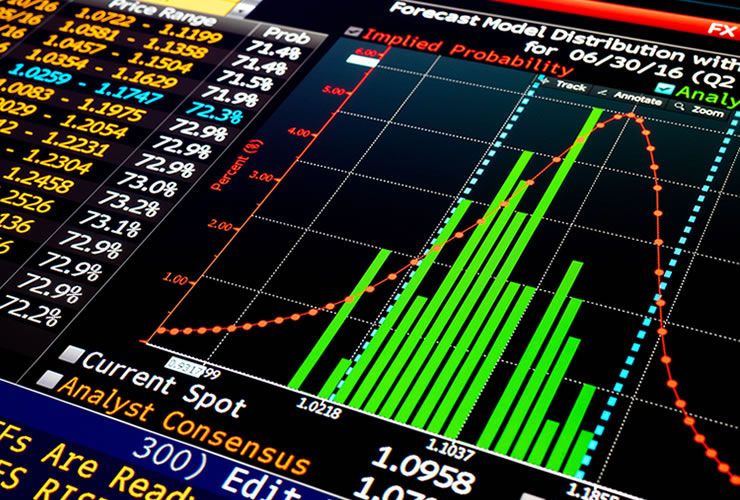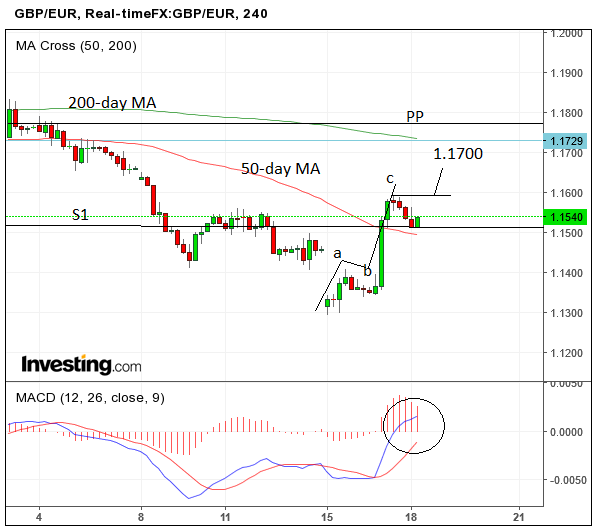GBP/EUR Exchange Rate Rate Forecast: 1.17 Next

The British Pound retains an upward bias on Thursday 19 January as the impetus provided by Theresa May's convincing speech on her Governments position on Brexit remains alive.
As a result, tthe GBP to EUR exchange rate has staged an impressive reversal over the course of the past week, we have seen the conversion rise from a low of 1.1286 to a best of 1.1595.
The question we are mostly asked is whether the reversal constitutes the start of a new uptrend for Sterling - can the gains extend into a more substantial rally from here?
The truth is, it’s still a little too early to say.
From a technical point of view the only sign this could be the start of a stronger bullish trend is Tuesday’s massive up-day:
These sorts of long bullish days often mark the beginning of a young bull trend.
Or put another way – rare are those bullish reversals which do not start with a strong surge.
1.1700 Next Possible Target, 1.21 Possible Longer-Term
The four-hour chart above is useful for indicating the start of new short-term trends.
On GBP/EUR’s four-hour chart, however, the move up is still not evolved enough yet to denote a new uptrend.
It is still only composed of three waves which means it could just as likely be an a-b-c correction of the downtrend as a newborn uptrend.
Ideally, what is required to increase the certainty that the trend is going higher is a break above the current 1.1594 highs.
This would disprove the idea the move is just a three-wave correction and add more evidence to confirming it is a reversal, as it would indicate the trend of peaks and troughs had gone from down to up.
Such a move would probably lead to a rise to the next target at the major round number level of 1.1700.
Analyst Robin Wilkin at Lloyds Bank is meanwhile looking for GBP/EUR to retain an upside bias near-term.
In a communication to clients Wilkin says he sees a move down to test resistance at 1.1628/1.1682 but a break there is needed to confirm a more convincing recovery at this stage.
Overall, Lloyds believe this market is developing into a medium term range loosely between 1.1236 and 1.2121.
GBP/EUR Stalemate on Positive Data Releases
Major data out this morning has been positive for both the Euro and the Pound, resulting in little change in the GBP/EUR exchange rate.
The highlight of UK Data was the surprising rise in Average Wages of 2.8% versus the 2.6% expected.
This is likely to help offset fears that rising inflation squeezing household budgets, and provide Carney and the Bank of England (BOE) with more amplitude to raise interest rates if necessary.
Inflation data for the Eurozone, meanwhile, showed steady progress higher, with a 1.1% annualized rise and a 0.9% increase in Core.
This was a positive sign, prompting Xtrade’s Paul Siriani to say that he thought the data might embolden Germany to push for a cut in the stimulus programme at Thursday’s European Central Bank (ECB) council meeting.
“Today’s perky inflation figures are the latest sign that the European economy could surpass expectations in 2017. Cutting the sustained stimulus programme will surely be high up on the agenda at Thursday’s Council meeting, with Germany the main protagonists However, ECB President Mario Draghi is likely to remain cautious of the road ahead. Concerns over political turbulence in the coming months may continue to influence monetary policy more than recent data,” said Siriani.
Core Inflation is more important to the ECB in their decision making, than Headline inflation, which is currently influenced by temporary rising oil and commodity prices.
The lack of a strong trend higher in Core prices may still be too much of a concern for the ECB to make them wind down their money-printing programme.
Remember - signs that the ECB is about to wind down their money-printing programme is important as it signals the potential for significant strength in the Euro going forward.
The two charts below show how much more Headline has been rising as compared to Core CPIH:
Analysts at TD Securities, meanwhile, expected the ECB to maintain, “the same message as at the December meeting, but that there might be risks to the upside.”
They see risks for the Euro now tilted to the upside, at least against the Dollar, anyway.
Save


